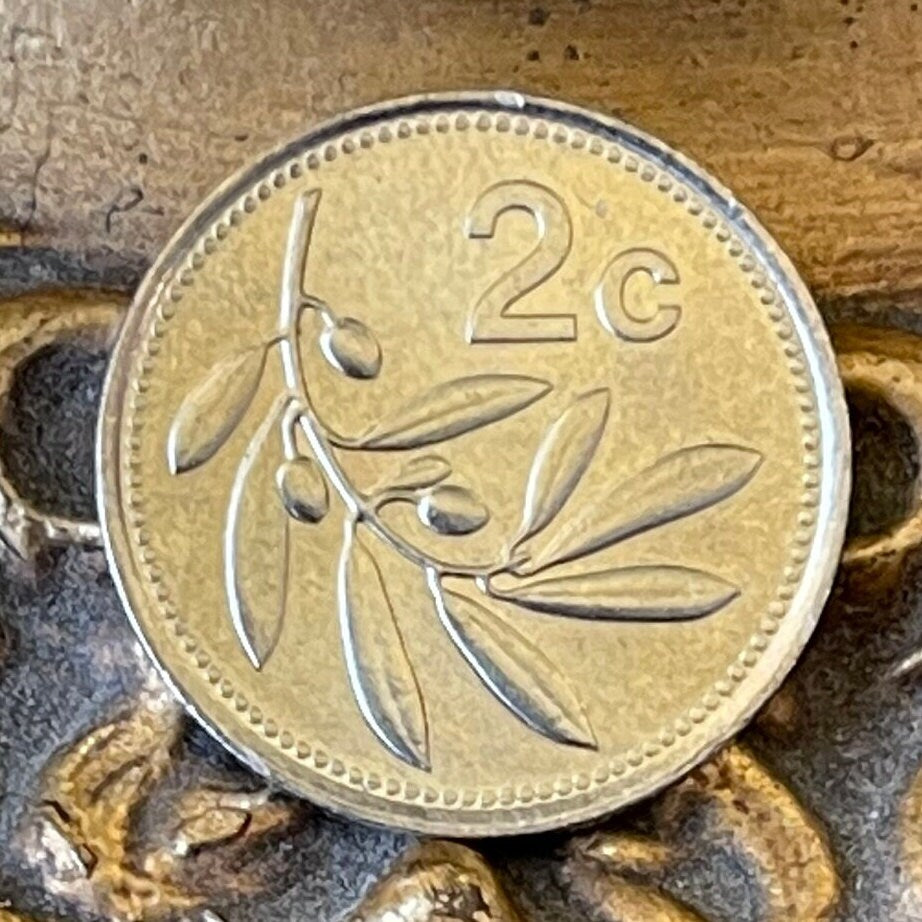elemintalshop
Olive Branch 2 Cents Malta Authentic Coin Money for Jewelry and Craft Making (Peace) (Victory)
Olive Branch 2 Cents Malta Authentic Coin Money for Jewelry and Craft Making (Peace) (Victory)
Couldn't load pickup availability
Olive Branch 2 Cents Malta Authentic Coin Money for Jewelry and Craft Making (Peace) (Victory)
Reverse: Olive branch
Lettering: 2 c
Obverse: Coat of arms of Malta
Lettering: MALTA
REPUBLIKA TA'MALTA
Edge: Reeded
Features
Issuer Malta
Period Republic (1974-date)
Type Standard circulation coin
Years 1991-2007
Value 2 Cents (0.02 MTL)
Currency Lira (1972-2007)
Composition Copper-nickel
Weight 2.26 g
Diameter 18 mm
Thickness 1.28 mm
Shape Round
Technique Milled
Orientation Medal alignment ↑↑
Demonetized 1 February 2010
Number N# 1779
References KM# 94, Schön# 93
Wikipedia:
The olive branch is a symbol of peace or victory allegedly deriving from the customs of ancient Greece, particularly regarding supplication to both the gods and persons in power and is found in most cultures of the Mediterranean basin. It became associated with peace in modern Europe and is also used in the Arab world. Despite claims of Ancient Greek origins, the symbol first appears in Ancient Egypt as a symbol of peace many centuries before appearing in ancient Greek mythology.
In Greek tradition, a hiketeria (ἱκετηρία) was an olive branch held by supplicants to show their status as such when approaching persons of power or in temples when supplicating the gods.
In Greek mythology, Athena competed with Poseidon for possession of Athens. Poseidon claimed possession by thrusting his trident into the Acropolis, where a well of sea-water gushed out. Athena took possession by planting the first olive tree beside the well. The court of gods and goddesses ruled that Athena had the better right to the land because she had given it the better gift. Olive wreaths were worn by brides[4] and awarded to olympic victors.
The olive branch was one of the attributes of Eirene on Roman Imperial coins. For example, the reverse of a tetradrachm of Vespasian from Alexandria, 70-71 AD, shows Eirene standing holding a branch upward in her right hand.
The Roman poet Virgil (70–19 BC) associated "the plump olive" with the goddess Pax (the Roman Eirene) and he used the olive branch as a symbol of peace in his Aeneid:
High on the stern Aeneas his stand,
And held a branch of olive in his hand,
While thus he spoke: "The Phrygians' arms you see,
Expelled from Troy, provoked in Italy
By Latian foes, with war unjustly made;
At first affianced, and at last betrayed.
This message bear: The Trojans and their chief
Bring holy peace, and beg the king's relief."
For the Romans, there was an intimate relationship between war and peace, and Mars, the god of war, had another aspect, Mars Pacifer, Mars the bringer of Peace, who is shown on coins of the later Roman Empire bearing an olive branch. Appian describes the use of the olive-branch as a gesture of peace by the enemies of the Roman general Scipio Aemilianus in the Numantine War and by Hasdrubal the Boeotarch of Carthage.
Although peace was associated with the olive branch during the time of the Greeks, the symbolism became even stronger under the Pax Romana when envoys used the olive branch as tokens of peace.
******
Wikipedia:
The present coat of arms is described by the Emblem and Public Seal of Malta Act of 1988 as a shield showing an heraldic representation of the national flag of Malta; above the shield a mural crown in gold with a sally port and five turrets representing the fortifications of Malta and denoting a city-state; and around the shield a wreath of two branches: the dexter of olive, the sinister of palm, symbols of peace and traditionally associated with Malta, all in their proper colours, tied at base with a white ribbon, backed red and upon which are written the words Repubblika ta' Malta (“Republic of Malta” in Maltese) in capital letters in black.
The various coats of arms appear on passports, excise stamps, official documents and various other uses. Many Maltese coins feature a coat of arms, most notably the second series of the Maltese lira, some Maltese euro coins, and many gold or silver commemorative coins (either denominated in the Maltese lira or in Euro). Coats of arms were featured various times on Maltese postage stamps as well.
Share



















